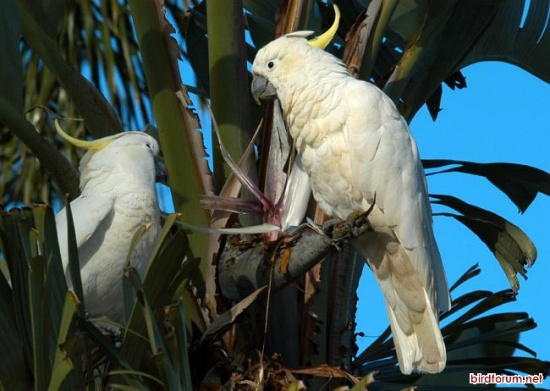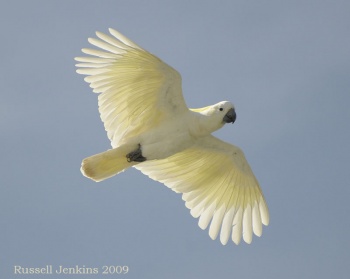m (→Taxonomy: fix link) |
(Flight photo. Taxonomy expanded. Links. References) |
||
| Line 1: | Line 1: | ||
;[[:Category:Cacatua|Cacatua]] galerita | ;[[:Category:Cacatua|Cacatua]] galerita | ||
| − | [[Image:Sulphur-crested_Cockatoo.jpg|thumb|550px|right|Photo by Eric<br> | + | [[Image:Sulphur-crested_Cockatoo.jpg|thumb|550px|right|Photo by {{user|Eric|Eric}}<br />Newport, [[New South Wales]], [[Australia]]]] |
==Identification== | ==Identification== | ||
| − | + | A large white cockatoo (typically measuring 45-50cm). It has a distinctive long yellow crest, and a yellow wash over the ears and under the wings and tail. <br /> | |
| − | + | Sexes are similar, however they can be distinguished on eye colour. Males have dark brown eyes while females have a more reddish-brown eye. Juveniles resemble adults. | |
==Distribution== | ==Distribution== | ||
| − | + | [[Image:DSC5915.jpg|thumb|350px|right|Photo by {{user|stoop|stoop}}<br />Pittsworth, [[Queensland]], [[Australia]], January 2009 ]] | |
| − | + | Widespread and common in eastern and northern [[Australia]] from Adelaide in the west and [[Tasmania]] in the south to Cape York and across to the Kimberly in the north. There is a feral population established in Perth, [[Western Australia]]. The Sulphur-crested Cockatoo also occurs in [[Papua New Guinea]] and the [[Aru Islands]], and there are feral populations in [[Indonesia]] and [[New Zealand]]. | |
==Taxonomy== | ==Taxonomy== | ||
| − | The Sulphur-crested Cockatoo is placed with the family Cacatuidae within the order Psittaciformes. Other members of the ''Cacatua'' genus include the [[Pink Cockatoo|Major Mitchell's Cockatoo]] in Australia, the [[Yellow-crested Cockatoo]], [[Moluccan Cockatoo]] and [[Umbrella Cockatoo]] in Indonesia and the [[Blue-eyed Cockatoo]] in Papua New Guinea. | + | The Sulphur-crested Cockatoo is placed with the family Cacatuidae within the order Psittaciformes. Other members of the ''Cacatua'' genus include the [[Pink Cockatoo|Major Mitchell's Cockatoo]] in Australia, the [[Yellow-crested Cockatoo]], [[Moluccan Cockatoo]] and [[Umbrella Cockatoo]] in Indonesia and the [[Blue-eyed Cockatoo]] in [[Papua New Guinea]]. |
| − | + | ====Subspecies<sup>[[#References|[1]]]</sup>==== | |
| + | *''C. g. triton'': | ||
| + | :*[[New Guinea]] and adjacent islands | ||
| + | *''C. g. eleonora'': | ||
| + | :*Aru Islands | ||
| + | *''C. g. fitzroyi'': | ||
| + | :*Northern [[Australia]] (Fitzroy River to Gulf of Carpenteria) | ||
| + | *''C. g. galerita'': | ||
| + | :*Eastern and south-eastern [[Australia]] (Cape York to Adelaide, King Island, [[Tasmania]]) | ||
==Habitat== | ==Habitat== | ||
Open woodland, agricultural districts and around human settlement | Open woodland, agricultural districts and around human settlement | ||
| − | |||
==Behaviour== | ==Behaviour== | ||
| − | Birds breed in monogamous pairs, using tree hollows for nesting. Outside of the breeding season Sulphur-crested Cockatoos congregate in large flocks, feeding on berries, seeds, nuts, roots, grubs and grain either on the ground or in trees. Typically feeding groups post one or more lookouts in nearby vantage points to watch for danger | + | Birds spend much of their time in play, characteristically and famously breaking and dropping branches, chewing house decking and panelling and removing rubber sealing on street lights. |
| + | ====Breeding==== | ||
| + | Birds breed in monogamous pairs, using tree hollows for nesting. | ||
| + | ====Diet==== | ||
| + | Outside of the breeding season Sulphur-crested Cockatoos congregate in large flocks, feeding on berries, seeds, nuts, roots, grubs and grain either on the ground or in trees. Typically feeding groups post one or more lookouts in nearby vantage points to watch for danger. | ||
| + | The species is considered a pest in agricultural areas, where it eats grain and orchard fruit. | ||
| + | ====Vocalisation==== | ||
Call: An extremely loud raucous screech, ending with an upwards inflection. Commonly uttered during flight. | Call: An extremely loud raucous screech, ending with an upwards inflection. Commonly uttered during flight. | ||
| − | + | ==References== | |
| + | #{{Ref-Clements6thDec08}} | ||
| + | #BF member observations | ||
==External Links== | ==External Links== | ||
{{GSearch|Cacatua+galerita}} | {{GSearch|Cacatua+galerita}} | ||
*[http://www.aviceda.org/abid/birdimages.php?action=birdspecies&fid=19&bid=146 View more images of this species on the ABID] | *[http://www.aviceda.org/abid/birdimages.php?action=birdspecies&fid=19&bid=146 View more images of this species on the ABID] | ||
[[Category:Birds]] [[Category:Cacatua]] | [[Category:Birds]] [[Category:Cacatua]] | ||
Revision as of 22:33, 3 July 2009
- Cacatua galerita
Identification
A large white cockatoo (typically measuring 45-50cm). It has a distinctive long yellow crest, and a yellow wash over the ears and under the wings and tail.
Sexes are similar, however they can be distinguished on eye colour. Males have dark brown eyes while females have a more reddish-brown eye. Juveniles resemble adults.
Distribution
Widespread and common in eastern and northern Australia from Adelaide in the west and Tasmania in the south to Cape York and across to the Kimberly in the north. There is a feral population established in Perth, Western Australia. The Sulphur-crested Cockatoo also occurs in Papua New Guinea and the Aru Islands, and there are feral populations in Indonesia and New Zealand.
Taxonomy
The Sulphur-crested Cockatoo is placed with the family Cacatuidae within the order Psittaciformes. Other members of the Cacatua genus include the Major Mitchell's Cockatoo in Australia, the Yellow-crested Cockatoo, Moluccan Cockatoo and Umbrella Cockatoo in Indonesia and the Blue-eyed Cockatoo in Papua New Guinea.
Subspecies[1]
- C. g. triton:
- New Guinea and adjacent islands
- C. g. eleonora:
- Aru Islands
- C. g. fitzroyi:
- Northern Australia (Fitzroy River to Gulf of Carpenteria)
- C. g. galerita:
Habitat
Open woodland, agricultural districts and around human settlement
Behaviour
Birds spend much of their time in play, characteristically and famously breaking and dropping branches, chewing house decking and panelling and removing rubber sealing on street lights.
Breeding
Birds breed in monogamous pairs, using tree hollows for nesting.
Diet
Outside of the breeding season Sulphur-crested Cockatoos congregate in large flocks, feeding on berries, seeds, nuts, roots, grubs and grain either on the ground or in trees. Typically feeding groups post one or more lookouts in nearby vantage points to watch for danger.
The species is considered a pest in agricultural areas, where it eats grain and orchard fruit.
Vocalisation
Call: An extremely loud raucous screech, ending with an upwards inflection. Commonly uttered during flight.
References
- Clements, JF. 2008. The Clements Checklist of Birds of the World. 6th ed., with updates to December 2008. Ithaca: Cornell Univ. Press. ISBN 978-0801445019.
- BF member observations





